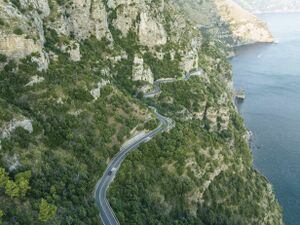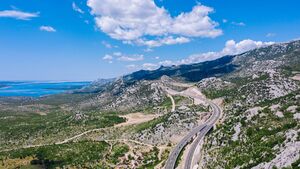Gorsko
This article is incomplete because it is pending further input from participants, or it is a work-in-progress by one author. Please comment on this article's talk page to share your input, comments and questions. Note: To contribute to this article, you may need to seek help from the author(s) of this page. |
Gorsko | |
|---|---|
| The Sovereign Island of Gorsko Njezavisli ostrov Gorska (Gorskan) Gorský suwerénní ostrow (Morrawian) | |
| Sovereign state | Morrawia |
| Duchy of Gorsko | c. 680 |
| Free Island of Zimor | 1204 |
| Sovereign Island of Gorsko | 1766 |
| Capital | Žimorj |
| Largest city | Glosnjik |
| Official languages | |
| Demonym(s) | Gorskan |
| Government | Devolved exeutive-led system within a presidential republic |
| Jana Koprovičova | |
| Maćej Źeľonic | |
| Natalia Zoltovićova | |
| Pavel Črni | |
| Legislature | Legislative sitting |
| National representation | |
| One non-voting delegate | |
| Area | |
• Total | 1,176 km2 (454 sq mi) (not ranked) |
| Highest elevation (Maćin) | 1,762 m (5,781 ft) |
| Lowest elevation | 0 m (0 ft) |
| Population | |
• 2024 estimate | |
• 2015 census | |
• Density | 105.43/km2 (273.1/sq mi) (not ranked) |
| GDP (PPP) | 2024 estimate |
• Total | |
• Per capita | |
| GDP (nominal) | 2024 estimate |
• Total | |
• Per capita | |
| Gini (2024) | medium |
| HDI (2024) | very high · not ranked |
| Currency | Morrawian Tollar (₮) |
| Time zone | UTC+01:00 |
| Date format | dd/mm/yyyy yyyy/mm/dd |
| Driving side | left |
| Calling code | +415 |
| ISO 3166 code | GO |
| Internet TLD | .go |
Gorsko (IPA: /gɒrˈskoʊ/), natively known as Gorsko (Ipa: /ˈgorsko/), is an Organized territory of Morrawia located on the Motach Island in the Alabaster Gulf, lying about /TBA/ kilometres away from the Morrawian mainland. The total land area is 1,176km2, occupying an oceanic climate zone strongly influenced by the Sunadic Ocean with warm summers and mild and humid winters. In the centre of the island the geography is hilly to mountainous, whilst on the coast it is largely flat.
The capital city is Žimorj, whilst Glosnjik with about 35 thousand residents, which is roughly 29% of the total Gorskan population of 124,064 inhabitants, leading to a population density of 105.43/km2. It is one of the most religious parts of Morrawia, with 95.6% of the population aligning with Christianity, 89.4% being Protestant and 6.2% Catholic. About 93.8% is ethnically Gorskan, with the vast majority of the remaining population, circa 5% of the population, being ethnically Morrawian. Gorsko has a unicameral legislature which assists the territorial governor of Gorsko. It is represented in the House of Representatives of Morrawia by a non-voting member, currently a representative of the Gorskan branch of the Republican party.
Gorsko is a developed high-income economy, which is in large part due to its status as a tax haven and offshore banking destination. The largest sector are services, mainly insurance, banking, information and communication technology and online gambling. Whilst this status has greatly boosted the Gorskan economy, it has lead to money laundering, financial crime, and terrorism financing issues. The country vaguely follows the Morrawian welfare system, with free healthcare and education for all.
Etymology
Geography and enviroment
Topography
Geology
Flora and fauna
Terrestrial ecology
Protected areas
Climate
Enviromental issues
History
Demographics
Population
Ancestry
Language
Religion
Birth data
Economy
Taxation
Cost of living
Information and communication technology
Culture
Customs and etiquette
Cuisine
Mythology
Literature, art and film
Music
Architecture
Clothes
Sports
Tourism
Health
Education
Public schools
Private schools
Colleges and universities
Transportation
Roads
Building roads has always been difficult in Gorsko due to its mountainous terrain, although after decades of effort, a system of highways has been constructed, starting with the G-1 interstate, the only interstate located on the island. First proposed in 1972 by Jan Vrbi, a Gorskan civil engineer, his proposal was initially denied due to predicted traffic volumes in Gorsko not warranting a highway of such size. In 1984 the proposal was picked up again and tweaked by federal engineers to follow Gorsko's challenging terrain more faithfully. In 1988 the first visualisation was released to the public, sparking outrage in Gorsko due to cutting through protected terrain. After 2 years the final agreement on the interstate's route was reached, with construction starting in 1991, expected to be finished in 1998, however complications associated with the two tunnels' construction delayed the opening to 2004. The highway starts in the Port of Glosnjik, wrapping around the city of Glosnjik itself, after which it passes through a tunnel in the Janjicke Alpi and heads south following the coast through another tunnel until eventually reaching the capital city of Žimorj.

Gorsko is also home to four teritorrial highways which make up the majority of Gorskan highways. Three of these have been fully funded and built by the Gorskan teritorrial government, whilst the G-10 was funded by the federal government of Morrawia as an extension to the G-1 interstate. The first of these highways, the G-11 was proposed in 1995 and put to public vote in 1996, passing by a narrow margin of 2.7%. Construction started in 1997 and finished in 2004 without delays, shortly after the G-1, completing the highway ringroad. It, like the interstate, features two tunnels, however it is also completed by the Most Viktora z Butković suspension bridge over the Črnjeć river in the north-western part of the island. The second teritorrial highway to be finsihed was the G-12 in eastern Gorsko, connecting the Stupka peninsula to the interstate. Like the G-11, it went through a public vote in early 2005, with construction starting in late 2005 and finishing in 2008 with a delay of three months due to a sudden material shortage. The last extension, the G-13, was approved without a public vote in 2012 and was finished in 2014, serving as a connector between the G-11 and northern Gorsko.
Public transportation

Public transportation is an important mode of travel for both locals and visitors in Gorsko, connecting all settlements on the island by rail or bus services, with about 31% of the daily trips made on the island being handled by public transportation. All public transportation is kept up by the government-owned Gorskan Integrated Transportation (Gorskan: Gorska Integrovana Prjepravica), which has been serving the island since the construction of the first rail link between Žimor and the neighbouring village of Doljina in 1964. The Gorskan rail network has since grown to 207 km thanks to intense investment from the Gorskan and Morrawian governments, with all lines being electrified with an alternating current at 15kV. A common issue that had to be addressed during the construction of the network and still causes significant difficulties in Gorsko's infrastructure of all kinds is its mountainous terrain. Due to this, a narrow gauge railway with the gauge of 3 ft 6 in (1,067 mm) was used, which allows for cheaper construction as well as manipulation in steep terrain and narrow turns.
The second most used form of public transportation right after railways are buses, which serve small villages and areas difficult or impossible to reach by train. All buses in Gorsko are low-floor buses due to concerns of accessibility, especially for senior citizens and wheelchair users. The first bus link on the island was established in 1934 during a period of modernization in Gorsko by a private operator called Gorski Busi, which handled all bus operations on the island except inner-city bus travel in Glosnjik, which was operated by Gorskan Integrated Transportation that later purchased and incorporated Gorski Busi into its structure in 1972 for 10,193,476 ₮ (ACU 2,548,369). Gorsko is also served by a ferry service that connects it with the Morrawian mainland.
Governance
Political subdivisions and local government
State government
Federal government
Politics
Law enforcement
Gorskan sovereignity movement
See also


